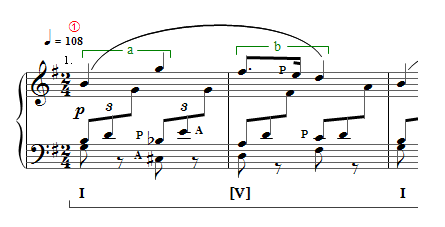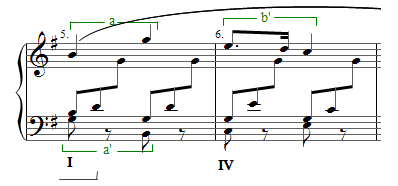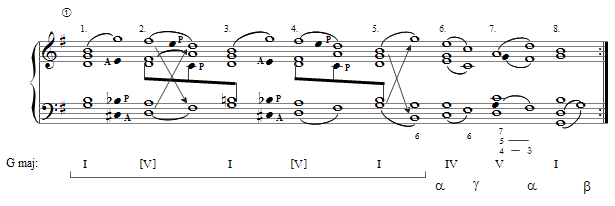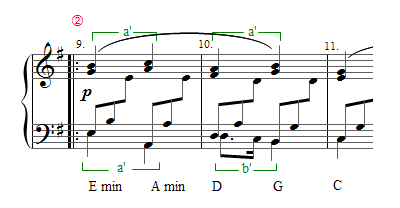CHAPTER 8 - EXAMPLE MUSICAL ANALYSES
SCHUMANN - KINDERSZENEN NO. 1
Steps 2 and 3 - Identify the Surface Voice Leading and Root Progression Patterns
As the surface voice leading in this piece is fairly simple, we can examine the voice leading and reveal the underlying root progressions in one step. If you are not familiar with voice leading analysis, I suggest you first read the Voice Leading Appendix.
The voice leading analysis enables us to understand how the melodic structure of the music arises from the surface voice leading. The surface of the music is made up of voice leading patterns which combine together and with rhythmic patterns to form motivic patterns. These are the smallest units of melody that combine to form larger melodic structures. The motivic patterns are developed throughout the melody to give the melody unity. If we strip away the voice leading surface, we uncover the underlying root progression patterns which give the music its musical phrase structure. The root progression analysis and its implications for musical phrase structures is the main topic of this work.
Please refer to the Schumann Piano Score and the first page of the Schumann Analytical Outline. I suggest you print off each of these. See notes in the previous section.
The Piano Score shows aspects of the voice leading and the resulting motives. Voice leading patterns are shown as: 'A' for auxiliary note, 'P' for passing note etc. Motives are shown as a, b, with horizontal brackets. Where motives are repeated, altered in some way, They are shown as a' and b'. Please also refer to the Glossary of Symbols for a full explanation of all symbols used.
The Analytical Outline contains full details of the voice leading, root progression and phrase structure information to the extent that it should be possible to understand those aspects of the analysis totally from that. However, the following description may help, especially if you wish to understand the motivic analysis and other details of the piece. Remember that in the Analytical Outline, the notes represent actual notes in the music but not the duration of the notes. White notes (minims) represent structural notes and black notes represent voice leading elaborations of the underlying structural chords. Slurs are used to connect together structural notes that belong to the same chord (arpeggios and repeated notes) so that the extent of a single structural chord may be easily seen. Please refer to the Glossary of Symbols for a full explanation of all symbols used.
The texture of the music consists of a melody line and a bass line constructed from the same voice leading and motivic patterns. The middle voice consists throughout of three part harmony which is arpeggiated in triplets. This arpeggiation is also a voice leading pattern which elaborates the underlying chords. In the analytical outline, the arpeggiation is reduced to vertical chords so that the arpeggios appear as three voices. Thus we can see that the whole piece is constructed in 5 voices and we can see the voice leading within each voice.
Phrase 1 (bars 1 to 8).
The following extract of the first two bars of the music shows that the surface voice leading is made up of: arpeggios, passing notes and auxiliary notes.

In bar 1, the voice leading in the melody consists of an arpeggio from the 3rd of the tonic chord (B) up to the root of the same chord (G). In bar 2 the voice leading consists of an arpeggio from the 3rd of the dominant chord (F#) down to the root of the same chord (D). The arpeggios are shown in the analytical outline as slurs. (See below for an extract) The arpeggiation in bar 2 is further elaborated by the E passing note which fills in between the F# and D. The passing note is shown in the piano score and in the analytical outline by the letter "P". These voice leading patterns create two motivic elements. The rising 6th from B to G in the first bar is shown as motive "a" and in bar 2, the arpeggio plus the passing note is shown as motive "b". The dotted rhythm is also part of the second motive. The whole piece, including the melody, bass line, and at times the middle voices, is constructed from these two motives. Motives "a" and "b" together form a larger 2 bar motive ("a + b"). We could designate this as the basic motive of the piece. However, I have divided it up into "a" and "b" since each element is developed in its own right. I have shown versions of the basic motives which have been modified in some way as " a' " and " b' ".
If we examine the underlying harmony, we can see that there is a diminished 7th chord in bar 1. This whole chord results from voice leading. The Bb is a passing note descending from B natural in the G chord to A in the D chord. This is shown most clearly in the analysis outline (see extract below). This descending three note pattern is a chromatic simplified version of motive "b". Within the same chord, the E is a diatonic auxiliary note ( D - E - D in one of the middle voices) and the C# is a chromatic auxiliary note, both marked "A" in the Piano Score and Analytical Outline. It is the B - Bb - A movement that drives this chord succession, supported by the two auxiliary notes. We might expect that the C# auxiliary note be preceded by a D in the bass. But the D is not actually in the bass part, here, as the first chord of the piece is required in root position. The D is nevertheless a member of the G chord. The G is sustained from the preceding G chord. The diminished 7 chord is thus a non-functional chord which decorates the underlying root progression pattern (which is: I - V) . The diminished 7th chord is also a non-functional chord by its very nature. Whilst the tonic and dominant chords are triads with a 5th which helps the ear identify the root of the chord, the diminished 7th chord has no perfect 5th. It is totally ambiguous as it is made up of three equal minor 3rds. It is not possible for the ear to determine a root for this chord. For these two reasons, it is heard as a voice leading elaboration of the underlying (I -V) root progression.
The diminished 7th chord, here, does not signify a modulation as there is no cadence in another key and no other key is established. It is purely a chromatic chord which decorates the underlying G tonality. The significance of the use of this chromatic chord, so early in the piece, may be in the title. "From Foreign Lands and People". The function of the diminished 7th chord could be to suggest a foreign harmony "From Foreign Lands" as it is chromatic in the G major tonality.
The bass, in the first phrase, follows the contour of the melody, but in contrary motion so that the melodic patterns in the bass are made up of an inverted form of motive "a" in bars 1 and 3 and non-inverted in bars 2 and 4, but with shorter duration notes. These fall when the melody rises and vise versa until the cadence where the bass remains stationary underpinning the cadential dominant chord.
Bars 3 and 4 are an exact repeat of bars 1 and 2. and bar 5 is a simplified version of bars 1 and 3, sustaining the tonic chord, so that in bars 1 to 5 the underlying harmony is the static harmony pattern:
I - V - I - V - I
Static harmony using chord V as the auxiliary chord is common in secular music of this period and in the classical period. (Whereas static harmony using chord IV is often a characteristic of sacred music - see the next analysis - of the Brahms St Antoni Chorale.) The type of chord progression used for static harmony is an indicator of the style or mood of the piece. The horizontal square bracket shows the extent of the static harmony.
If we examine the middle voices at bars 2 to 3 (see extract above) and at bars 4 to 5 we can see that in both places there is a descending pattern made up of a passing note C which fills in between the D of the dominant chord to the B of the tonic chord. This voice leading pattern is very common way of elaborating an underlying V - I chord progression (by adding a passing 7th to the dominant chord). This pattern is also a simplified version of the motive "b". This is shown in the analytical outline as "P" connected by a beam. I've shown a beam here just to make this progression clearer to see. Thus we can see that the top line, the middle voices and the bass are all connected by the use of similar motivic patterns. This helps to give the music unity.
The analytical outline also shows that in bar 2, whilst in the melody, the F# is arpeggiated down to D, the bass movement is the exact opposite so that the bass D is arpeggiated up to F#. This is sometimes referred to as "voice exchange" as the voices exchange notes. This is a common voice leading pattern used to briefly elaborate or prolong a single chord. There is a further example at bar 5. This time, within the tonic chord. In this instance, both voices move through a 6th. Voice exchange is shown in the analytical outline by crossing arrows. There is also a voice exchange in bar 6 within the subdominant chord.

Bars 5 and 6 are similar to bars 3 and 4 but this time the second bar of the pair is altered. The motive b' in bar 6 descends from E instead of F# in order to support the changed harmonic progression, this time, from chord I to chord IV. This is the start of a dynamic harmony segment. This shows how melodies characteristically maintain motivic patterns whilst adjusting these to the underlying chord progressions. The change in chord progression is required here to give structure to the musical phase by a change from a static harmony to a dynamic harmony.

Bar 7 is based on motive "a" but this time the pattern ascends by a 4th and then falls by a third to a minim at bar 8. This alteration is necessary to form the V - I perfect cadence (or full close). The dynamic harmony (including the preceding chord and the cadence), is thus as follows:
I- IV - V - I
This is typical classical dynamic harmony composed of two rising 4th (α) progressions and one rising 2nd (γ) progression. This can be clearly seen in the analytical outline (see extract above). The type of chord progressions used in dynamic harmony is an indicator of the style of the music. In common practice tonality, three of the possible chord progressions are used to the almost total exclusion of the other three possibilities. See Chapter 2: Dynamic Harmony. The move from the G chord at the end of the this phrase to the first chord of the next phrase (E minor) is a falling 3rd (β) progression. This is the third common type of progression used in dynamic harmony in this period and is used to connect this phrase to the next phrase.
It is important to mention the middle voices, here, as there is a voice leading pattern in the form of a suspended 4th that resolves onto a third from the bass. The voice leading movement is shown in the analysis outline (extract above) with a slur and also by figured bass below the stave. This is just one example of how the dominant chord of the cadence is normally decorated in some way. A prolongation or voice leading elaboration of the dominant helps to emphasise the fact that this is not an ordinary dominant but the dominant of the cadence. Such elaborations of the dominant at the cadence are very common and various methods are used as discussed in the rest of this website and book.
Note that, as this is a perfect cadence, at an important structural point in the music, i.e. at the end of a musical phrase, both dominant and tonic chords are in root position to give the cadence strength. A dominant to tonic cadence is by far the most structurally important and common full close in classical tonal music and is therefore a further indicator of style.
Phrase 2 (bars 9 to 14).
This phrase is section B of the formal structure. It shares motivic content with section A. However, in the first two bars the same motivic patterns are reduced to intervals of a rising 2nd as follows:

Each bar from bar 9 to 13 contains the same simplified version of motive "a" However, rather than an arpeggiation within a single chord, here these correspond to changes of harmony. These patterns form what is normally referred to as a "sequence". Each bar contains the same pattern but a note lower. This sequence indicates an underlying "cycle of falling 5ths" progressions which is the same as a cycle of rising 4ths (α) progressions as follows:
E min - A min - D - G - C - F# dim - B
However, the B chord does not continue the pattern by rising a further 4th to E minor. Rather it moves by a falling 3rd (β) progressions to a G major chord, thus interrupting the expected V - I cadence in E minor. So that the dynamic harmony continues as follows:
E min - A min - D - G - C - F# dim - B - G - C - D7 - G
The whole progression in thus in G major as follows:
vi - ii - V - I - IV - vii° - III - I - IV - V - I
If we examine the voice leading in the bass, we can see that bar 9 has a downward leap reminiscent of the upward arpeggio of motive "a" and bar 10 makes a direct reference to motive "b" in the form of the dotted step wise motion. So that in the second phrase the melody is taken up by the bass line, but in an altered way, to fit in with the dynamic harmony. Below is an extract from the Analytical Outline which shows the chord progression. In the outline, I have used the convention that minor chords are shown as lower case letters and major chords are shown as upper case letters. I have also shown roman numerals below these, taking all chords to be in G major.

Whilst this section shares motivic content with section A, it contrasts with it in two main ways. According to the first 2 bars, it appears that it could be a move to E minor. This key change is not the normally expected dominant key but the slightly more distant relative minor. The relative foreigness of this key could again be a reference to the title "From Foreign Lands and People". It shares this foreigness with the diminished 7th chromatic chord of bar 1 because the tonic chord E minor shares two notes with this diminished 7th chord - E and G and so could be said to expand on an idea initiated in bar 1. However, just as in bar 1, the foreign idea is short lived. The E minor to A minor progression continues as a chord progression in G as indicated in the analysis, above.
This phrase contrasts with the first in a further way. Whilst phrase 1 is a complete phrase structure with static harmony, dynamic harmony and a cadence, phrase 2 is made up totally of dynamic harmony followed by a cadence. As can be seen from the analysis outline, it utilises all three of the strong chord progression that are most commonly used in classical dynamic harmony and none of the other progressions. This represents 100% polarisation as is normally the case in common practice tonal music. This is thus another style indicator of the music. In the analytical outline, I have shown the chord progressions as roman numerals (relative chord names) so as to make the movement clear. We should note here that the rising 4th (α) progressions are all root movement by a perfect fourth with the exception of the progression from C to F#. This involves an augmented fourth progression. The inclusion of an irregular progression like this is common in a succession of rising 4th progressions as it is necessary to keep within the desired key and is a normal aspect of the syntax of dynamic harmony and of tonality in general.
The cadence of the phrase (bar 13 to 14) is weakened by the fact that the two chords are not in root position and the melody ends on the third degree of the scale. The dominant is in 3rd inversion as can been seen in the analytical outline and the tonic is initially present in first inversion. By a further example of voice exchange, the bass descends to the root and the melody rises to the third of the chord. The root position tonic chord has a fermata (pause mark) which indicates that it is the end of a phrase but the weakness of the cadence coupled with the incompleteness of the phrase (no static harmony) indicates that it must be connected to another phrase, in some way, in order to be completed. This connection is made by movement in 10ths between the middle voice and the melody. This moves upwards to the upbeat leading to the next phrase and then to the first chord of the next phrase. See Voice Leading Appendix.
Phrase 3 (bars 15 to 22).
This phrase is an exact reprise of the first phrase, with the small exception that the last bar contains sustained notes in the bass. This completes the overall structure which is A - B - A as described in the previous section.
General note.
It is worth making a note here about the use of parallel 5ths and octaves in this piece, especially as theories based totally on voice leading make a big issue of the avoidance of such parallels in "great music" and about the significance of "good voice leading" which should not include such parallels. In spite of the normal voice leading prohibition of parallels, there are several places where voices move in parallel octaves and/or 5ths in this piece. These can be seen most clearly in the analytical outline. For instance, moving from bar 1 to 2 and from bar 3 to 4 the melody and top middle voice move in parallel octaves, moving from G to F#. In bar 6, the melody and a middle voice move in parallel octaves from E to C, although the effect is softened by the inclusion of the D passing note in the melody. At bar 7 the suspension is duplicated in parallel octaves between separate middle voices. At bar 9 to 10 there are "hidden" parallel 5ths (where voices move in similar motion to a 5th) between the melody ( C to A) and the top middle voice ( E to D). (So that the 5th A - D is approached in the same direction in both parts). There is also an example of simultaneous parallel 5ths and octaves in bar 13 where the C to D movement in the lowest of the middle voices is duplicated in parallel 5ths and octaves in the higher middle voices.
The effects are softened due to the arpeggiation and it is difficult to totally avoid parallels when there are 5 voices involved. But this is further evidence that the structure of music is not governed purely by voice leading rules. Rather, it is governed by patterns in each of the three syntaxes (voice leading, chord progressions, phrase structures), working together to produce structure in music. Sometimes it is necessary or desirable to allow parallels in order to support the underlying chord progressions or phrase structures. However, it is worth saying that Schumann, in order to maintain independence of the melody and bass line, does avoid parallel 5ths or octaves between the melody and bass with the notable exception at bar 6 to 7 where there is a further "hidden" 5th between the melody and bass (replicated at bars 20 to 21). Hidden 5ths (where voices move in similar motion to a 5th), according to my analyses, are common in all periods of music in spite of what some theorists would say about avoiding them. See Voice Leading Appendix, Independence of the Voices.
Next Section - Phrase Structure Analysis and Summary.

